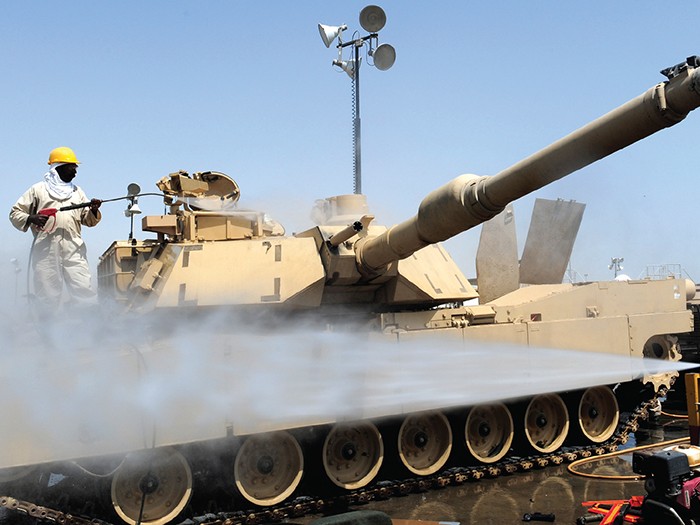Defense Contractor Risk
In Danger’s Path

Defense contractors in the Middle East work in some of the most dangerous and inhospitable conditions on the planet. Workers are drawn there by high pay rates, but face a long list of exposures.
Defense Base Act (DBA) insurance provides the sole workers’ compensation remedy for these employees, although some employers supplement that cover with employer liability coverage, in case of legal action from injured workers or third parties.
Provided through the Department of Labor, DBA coverage is congressionally mandated for civilian employees working outside the United States on military bases or under a contract with the government for public works or for national defense unless their employer obtains a waiver.
DBA carriers qualify for full reimbursement from the government for injuries caused by a “war-risk hazard” under The War Hazards Compensation Act.
Video: The DOL in 2009 reported that at least 1,688 civilian contractors in Iraq and Afghanistan died and more than 37,000 were injured, according to this Global Report TV broadcast.
Although conflict is spreading in the Middle East, many areas are not considered “conflict zones” where qualified injuries would be reimbursable by the federal government.
Still, DBA benefits are broad, said Karen Dobson, national client director, Aon Risk Solutions. They don’t officially provide 24-hour coverage, but they apply to many activities, sometimes even those as questionable as bar fights and softball injuries.
AIG has the lion’s share of the statutory DBA business, followed by CNA and ACE.
Neither the Department of Defense nor the Department of Labor releases statistics on the number of workers covered by the DBA, but the Business Benefits Group, a benefits consultant, reports that it covers almost 200,000 prime and subcontractor employees overseas and that it generates annual government-wide premiums of more than $400 million. DBA coverage extends to foreign nationals as well as U.S. citizens.
Contractors accounted for at least 50 percent of U.S. forces in Iraq and Afghanistan over the last decade, and before that, in the Balkans, said Moshe Schwartz, specialist in defense acquisition, before the House of Representatives’ Committee on Armed Services in October 2013.
High Risk and High Rewards
Despite its dangers and discomforts, the Middle East is an attractive place to work for many, said Aon’s Dobson, in large part because the work pays so well. For example, a truck driver who makes $40,000 per year in the United States may make $100,000 per year in the Middle East.
“An attorney will ask, ‘Is the worker’s heart condition or inflamed liver related to drinking bad water in Afghanistan?’ ” — Scott Bloch, a Washington, D.C. attorney who represents injured employees in many DBA cases.
But fundamental safety considerations sometimes get pushed to the back burner by extreme conditions. In challenging environments, such as 120-degree heat, “people just want to get the job done, and they’re not always focusing on safety procedures or taking the time to avoid risk,” said Alan Leibowitz, corporate director, environment, safety, health and security for Exelis Inc., a contractor with a large Middle East footprint.
Those shortcuts can lead to high injury rates. Workers in the Middle East are injured at least 10 times more frequently than their stateside equivalents, said Haleh Khodayari, chief executive officer, Advanced Consulting Inc., a global risk management firm based in California.
The costs in those cases can escalate rapidly due to exorbitant medical, medevac and repatriation expenses, in addition to lost time from work. The list of regional and war zone exposures is long and can be grisly, Khodayari said, ranging from slip-and-fall injuries to environmental exposures to death and injury from detonated roadside bombs and other extreme hazards from strife in the Middle East.
Post-traumatic stress and fatigue disorders occur frequently in Iraq and Afghanistan, sources said. The list of regional exposures includes allergies to foreign plants, such as palm pollen, and traffic accidents as workers try to negotiate unfamiliar or haphazard traffic patterns.
Adding to underwriters’ headaches is that the high compensation rates overseas sometimes motivate applicants to hide disqualifying ailments such as asthma or heart conditions during pre-employment screenings, which could put them at risk. It could also put their colleagues at risk if the safety of one depends on the unimpaired function of the other.
When DBA Applies
The Department of Labor is vigilant in its oversight of the DBA program, said Dobson, to the extent that it is “paternalistic” about looking after workers. In several cases, she said, the insurance company and claimant agreed on a settlement, but the DOL didn’t agree with the terms. It compelled the insurer to pay more, even though the claimants had competent legal representation.
Some disputes arise over whether or not idiopathic ailments, such as cancers and heart conditions, are related to employment, said Scott Bloch, a Washington, D.C. attorney who represents injured employees in many DBA cases.
“A DBA remedy could kick in if any aspect of the employment hastens or aggravates the conditions,” he said, which pulls the employer into complex legal and medical situations to prove or disprove a claim.
“An attorney will ask, ‘Is the worker’s heart condition or inflamed liver related to drinking bad water in Afghanistan?’ ”
To stave off financial crises in case DBA does not apply or while a case is in review, Bloch said, many employers offer their workers disability insurance over and above the workers’ compensation insurance to cover gaps that DBA may not cover.
Although DBA prevents employers from being hauled into civil lawsuits for its direct employees, employers may still be liable for third-party suits independent of DBA, Bloch said.
For example, if an employee leaves a live electrical cord that electrocutes a subcontractor in the shower, the employer may be subject to liability in civil court for action or inaction taken vis-à-vis the electrocuted subcontractor, who is a third party despite being part of “the team.”
The same pertains to any third party who wanders onto a work site or is struck by a contractor’s car.
Claims Management in Farsi
Language and distance often hobble claims management for injuries in the Middle East, said Terri Rhodes, CEO of the Disability Management Employer Coalition. U.S. doctors and carriers have to read medical reports from non-English-speaking countries to determine the nature and cause of injuries and whether they’re job-related.
They have to be able to read a treatment plan to arrange return-to-work. Even when she hires interpreters, Rhodes said, she never has full confidence that the interpretation is accurate.
“There’s always some variance in language,” Rhodes said.
Extracting, transporting and repatriating injured workers from conflict zones and remote regions to a location with adequate medical facilities can be complicated and expensive, said Eric Dean, senior vice president, ACE Risk Management Global Casualty.
DBA insurance provides coverage for repatriation. But problems multiply when a worker is medically incapacitated and can’t speak, Rhodes said, and it becomes necessary to obtain medical records.
“We have to communicate with hospitals,” she said, “and we run into time zone problems. In an emergency, we have to find out immediately when the injured worker was admitted and what the injury is.”
As elsewhere, incident prevention in the Middle East is the best claims management strategy, to whatever extent that’s possible in an environment where explosives and extreme heat are a fact of life.
Michael Baker International, a global engineering, planning and integrated consulting firm, strives for a “zero-incident, zero-accident” workplace at every site around the world, said Nicholas Gross, chief operating officer, international operations. That pays off both in protection of its employees and in its claims experience: Last year, Michael Baker International got “the best DBA rates in history,” Gross said.
“Our safety record has a direct benefit on our bottom line.”
Industry best practices include thorough pre-and post-employment screens, which include medical, dental and psychological exams, followed up with checkups during deployment, even in war zones, Aon’s Dobson said.
Michael Baker keeps a solid, detailed documentation trail about every incident, illness and injury, which ensures that injured employees get swift treatment and also protects the company against future claims.
Like Michael Baker, Exelis spends a lot of resources training its workers, both U.S. and foreign nationals, in safety protocols. It holds workers in the field to the same standard as its U.S. offices and factories.
Safety protocols could include redundant testing for electrical current on a rewiring site — an important precaution where infrastructure is cobbled together and wiring is “not always the safest,” Exelis’ Leibowitz said. It also includes forced hydration breaks, because people don’t notice heat exposure until it’s too late.
Compliance is high, Leibowitz said, because workers appreciate that the protocols are in their best interest. Exelis offers incentives for following safety rules and applies penalties, such as being sent home, for breaking them.
Return-to-work programs for Middle East contract workers can be hard to implement, Advance Consulting’s Khodayari said. A fairly simple injury such as a broken leg can be treated in most regions of the Middle East, but the worker can’t get back to work as quickly as in the U.S. because light duty assignments are not usually available.
The cost of lost wages can be high because the DBA entitles some injured workers to full wage loss for the rest of their lives.
“If a worker can’t return to the original contract, we may conduct a formal Labor Market Survey and help the injured worker look into other jobs with the same employer in a different capacity,” Khodayari said.
Gross attributes much of Michael Baker International’s safety success to its proactive approach — and to its partnership with its broker and DBA insurance provider.
“Our broker took an active role in identifying and managing risk, reducing claims and getting personnel back to work,” he said. “Our partnership with our carrier helped us reduce claims and experience.”
And key to the successful relationship, said ACE Group’s Dean, is working directly with the client, face to face when possible.
“Insurance is a contract of trust. Putting a face to the name helps build that trust,” he said, even with statutory coverage, such as DBA insurance.
“The relationship doesn’t change the coverage, but it facilitates the placement of coverage.”












